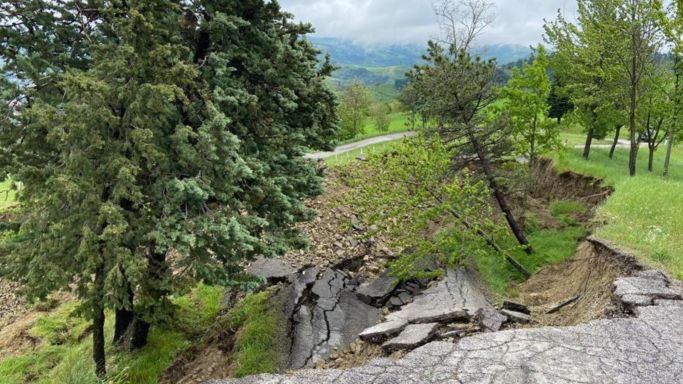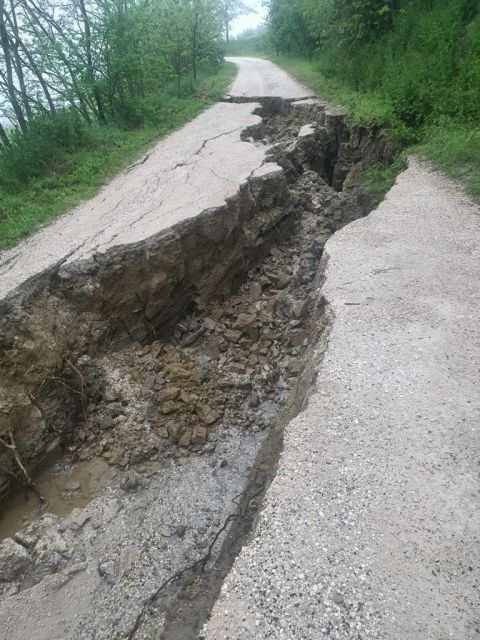22 May 2023 Walter sends this update after more heavy rains have exacerbated the catastrophic flooding in Romagna.
More rain, as much as six months’ worth, fell in three days between 15 and 17 May hitting particularly hard the area between Faenza, Cesena and Ravenna that is still reeling from landslides in the surrounding hills caused by heavy rains a fortnight ago. The flooding is the worst in 100 years with the death toll standing at 15 and with over 36,000 people displaced after having been forced to leave their homes. The rains have caused over 20 rivers to burst their banks and have inundated houses, shops and churches. Last Friday the A1, the main highway connecting Bologna with Florence, was blocked due to landslides.
Modigliana, which was one of the places worst hit by landslides and still cannot be reached, has been without electricity, telephone and mobile connections. Renzo Moressi, who, with his wife Maria Adele Ubaldi, runs the Casetta dei Frati estate in Modigliana, in a text message called the catastrophe ‘our manifest destiny … The same marl-and-sandstone [soils] that makes our wines so spicy, salty and minerally, are prone to landslides since the very inception of our viticulture!’
Moressi pointed out that landslides caused by heavy rains are a natural feature in this part of Romagna: ‘in 1634 the [River] Ibola flood was so disastrous that the Modiglianesi, then under the rule of Florence’s Medici, dug out an entirely new course for the river outside the walls of the city in just one summer, a Cyclopean work which can only be explained by the despair and the awareness that what had happened last in 1634 would happen again and again. We are missing this awareness today.’
In the lower parts of Romagna the torrential rains that caused rivers to burst hit a sewage system already at the point of breakdown, flooding towns and fields. Giorgio Melandri, who lives in Faenza, reports that parts of the centre have been inundated with water as high as two metres (over 6 ft) and can be reached only in a dinghy.
Francesco Bordini, of Villa Papiano in Modigliana and also living near Faenza in the plain, told me he is stuck at home surrounded by water. Aerial videos show thousands of hectares of agricultural land inundated and emergency helicopter teams rescuing people from their rooftops where they sought refuge from the rapidly rising water. This catastrophe comes on the heels of last year’s extreme drought, which reportedly led to a 45% reduction in crops; even heavier losses are expected this year.
Last Friday due to the floods the Emilia Grand Prix in Imola was cancelled owing to safety concerns of the organisers as well as the drivers. It comes at a particularly sensitive time for the coastal area on the Adriatic, an important international tourist destination, which has also been hit hard by the flooding and is still recovering from enormous economic losses caused by COVID-19 in 2020.
Modigliana, so far, has not set up an emergency fund for donations. For Moressi: ‘Our ancestors chose to cultivate these marginal soils in the hills out of necessity and found prosperity as well as natural disasters. We, on the other hand, have made the same choice consciously by following a dream: making wine our ancestors would have wanted to make if they would have known how, exactly on these difficult and precious soils, theirs and ours.’
9 May 2023 A state of emergency has been declared in Romagna after torrential rain has caused wide-scale landslides.
On 1 May, 30 hours of heavy downpours triggered landslides and the wholesale destruction of vineyards and roads in the area around Faenza and surrounding hills. The magnitude of the disaster is so enormous that a state of emergency has been declared in the area. The national newspaper Corriere della Sera called the situation ‘without historic precedent’.
Giorgio Melandri, who makes wine in Modigliana under the Mutiliana name, reports receiving 242 mm (9.5 in) in 30 hours, causing landslides that have destroyed many roads. One farmer living close to the largest landslide in Monte Trebbio described, in tears, the day as one of thunder and roar caused by the landslides. Many vineyards in the area have been destroyed and Melandri predicts it will take years to repair the enormous damage.
Francesco Bordini, of Villa Papiano in Modigliana and consultant agronomist for many producers in this part of Romagna, described how the incessant downpour fell on completely dry soils. Since 2021, Italy has gone through a period of drought with very little rainfall. The soils were largely unable to absorb the torrential rain, which inundated Faenza, Bagnacavallo and Conselice, forcing the evacuation of many families. Bordini reports that the landslides are of such magnitude, some having created canyons, that it is hard to imagine that rain and not an earthquake were responsible. The damage has also destroyed roads, making daily activities such as transporting bottles and getting fuel for tractors almost impossible.
In an email Bordini pointed out that many problems could have been avoided through sensible agricultural practices, the most important of which are to open and repair the many ditches into which water can flow, to cut the trees that are too close to the roads, to clear the sewer system in the hills and to check ditches and moats after prolonged periods of drought.
Bordini calls these procedures simple, but laborious and of little interest to local politicians and therefore ignored – at enormous cost as evidenced by the scale of destruction in Faenza and surroundings. ‘I hope that these aspects are going to be considered in the future’, Bordini concluded.
While the weather has been stable during the last week, the forecast is for more heavy rains in the next few weeks.


